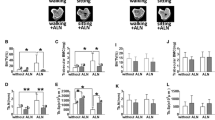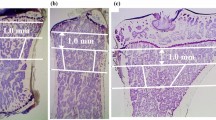Abstract
The effects of parathyroidectomy and acetazolamide on the changes in bone mass which occur following immobilization were studied in male and female rats. The forelimb was immobilized by sectioning the right brachial nerve plexus. At 10 to 14 days following denervation, both humeri were removed. The dry weight of the bones was determined and the difference between the weight of the bones from the intact and denervated, limbs was used at an index of the denervation response. Animals were either parathyroidectomired or placed on a diet containing 0.5% acetazolamide sodium at the time of denervation. Parathyroidectomy inhibited the development of the denervation response to the extent of 45%, 30%, and 85% in three experiments. Acetazolamide, incorporated as the sodium salt in laboratory chow at a concentration of 0.5%, also blocked the development of the denervation response. In three experiments, treatment with the drug for 10 to 14 days inhibited the response 42%, 47%, and 64% respectively. Under conditions of pair-feeding 0.5% acetazolamide incorporated in the diet caused a slight but significant hypercalcemia. It is concluded that parathyroidectomy and acetazolamide administration, both of which are known to inhibit bone resorption, are effective in significantly reducting the development of the bone mass changes, seen after denervation of the limb in the rat.
Résumé
Les effets de la parathyroidectomie et de l’acétazolamide sur la masse osseuse après immobilisation ont été étudiés chez les rats mâles et femelles. Le membre antérieur est immobilisé par section du plexus nerveux droit brachial. Dix à I4 jours après dénervation, les deux humerus sont prélevés. Le poids sec des os est déterminé et la différence entre le poids des os des membres intacts et sans nerf est utilisée comme une mesure de la réponse à la section nerveuse. Les animaux sont soit parathyroidectomisés ou soumis à un régime contenant 0,5% de l’acét-azolamide de sodium au moment de la section nerveuse. La parathyroidectomie inhibe le développement de la réponse à la section nerveuse de 45%, 30% et 85% au cours de trois expériences. L’acétazolamide, incorporé sous forme de sel de sodium dans la nourriture à une concentration de 0,5%, inhibe aussi la réponse à la section nerveuse. Au cours des trois essais, ce traitement appliqué, pendant 10 à 14 jours inhibe la réponse respectivement de 42%, 47% et 64%. En nourrissantles animaux par paire, 0,5% d’acétazolamide provoque dans l’alimentation une hypercalcémie faible mais significative. La parathyroidectomie et l’administration d’acétazolamide, qui inhibent chacun la résorption osseuse, provoquent une diminution significative du développment osseux après dénervation de la patte du rat.
Zusammenfassung
Die Wirkungen von Parathyreoidektomie und Acetazolamid auf die nach Immobilisation erfolgenden Veränderungen in der Knochenmasse wurden bei männlichen und weiblichen Ratten studiert. Das Vorderbein wurde mittels Durchschneiden des rechten Brachialnervenplexus immobilisiert. 10–14 Tage danach wurden beide Humeri entfernt. Das Trockengewicht der Knochen, wurde bestimmt, und der Unterschied zwischen dem Gewicht der Knochen intakter und der Knochen behandelter Glieder wurde als Index der Reaktion auf das Durch-schneiden der Nerven verwendet. Die Tiere wurden entweder parathyreoidektomiert, oder sie erhielten eine Diät, welche zur Zeit der Nervdurchtrennung 0,5% Acetazolamid enthielt. Die Parathyreoidektomie beschränkte die Reaktion auf das Durchschneiden der Nerven in drei verschiedenen Experimenten auf 45%, 30% und 85%. Acetazolamid, welches als Natriumsalz in einer Konzentration von 0,5% in der Diät enthalten war, hemmte die Reaktion auf das Durchschneiden der Nerven ebenfalls. Die Behandlung mit dieser Substanz während 10–14 Tagen setzte die Reaktion in drei Experimenten um je 42%, 47% und 64% hereab. Bei paarweiser Fütterung (pair feeding) verursachte 0,5% Acetazolamid in der Diät eine leichte, aber signifikante Hypercalcämie. Parathyreoidektomie und Acetazolamidverabreichung, welche bekanntlich beide die Knochenresorption hemmen, bewirken also eine signifikante Hemmung der Knochenveränderungen, welche nach dem Durchschneiden eines Nerves in einem Glied der Ratte auftreten.
Similar content being viewed by others
References
Armstrong, W. D., Knowlton, M., Gouze, M.: Influence of estradiol and testosterone proprionates on skeletal atrophy from disuse and on normal bones of mature rats Endocrinology36, 313–322 (1945).
Burkhart, J. M., Jowsey, J.: Parathyroid and thyroid hormones in the development of immobilization osteoprosis. Endocrinology81, 1053–1062 (1967).
Conaway, H. H., Waite, L. C., Kenny, A. D.: Inhibition of osteoporosis of dissuse in rats by acetazolamide, p. A-212 (Abstract). Program of 53rd Meeting of San Francisco: The Endocrine Society1971.
Delling, G., Schäfer, A., Schleicher, H. J., Ziegler, R.: The effect of calcitonin on disue atrophy of bone in the rat. Calcif. Tiss. Res.5, 143–150 (1970).
Dulce, H.-J., Siegmund, P.: Zur Biochemie der Knochenauflösung, II. Der Einfluß von Diamox auf das Plasma-Calcium östron-behandelter Hähne. Hoppe-Seylers Z. physiol. Chem.320, 160–162 (1960).
Fleisch, H., Russell, R. G. G., Simpson, B., Mühlbauer, R. C.: Prevention by a diphosphonate of immobilization “osteoporoiss” in rats. Nature (Lond.)223, 211–212 (1969).
Gedalia, I., Hodge, H. C., Anaise, J., White, W. E., Menczel, J.: The effect of sodium monofluorophosphate and sodium fluoride on bone immobilization in rats. Calcif. Tiss. Res.5, 146–152 (1970).
Gedalia, I., Schwartz, A., Sela, J., Gazenfield, E.: Effects of fluoride intake on disuse atrophy of bone in rats. Proc. Soc. exp. Biol. (N. Y.)122, 657–660 (1966).
Harrison, H. E., Harrison, H. C.: Inhibition of urine citrate excretion and the production of renal calcinosis in the rat by acetazolamide (Diamox) administration. J. clin. Invest.,34, 1662–1670 (1955).
Heaney, R. P.: A unified concept of osteoporosis. Amer. J. Med.39, 877–880 (1965).
Kenny, A. D.: Effect of dietary acetazolamide on plasma electrolytes, bone mass, and renal mineral contents in rats. Proc. Soc. exp. Biol. (N. Y.)140, 135–139 (1972).
Kenny, A. D., Toepel, W., Schour, I.: Calcium and phosphorus metabolism in theia rat. J. dent. Res.37, 432–443 (1958).
Kessler, G., Wolfman, M.: An automated procedure for the simultaneous determination of calcium and phosphorus. Clin. Sci.10, 686–703 (1964).
Lane, J. M., Steinberg, M. E.: Effects of the diphosphonate EHDP on disuse osteoprosis and bone mass in mature rats. (Abstract). Arthr. and Rheum.14, 170–171 (1971).
Maren, T. H.: Carbonic anhydrase: chemistry, physiology, and inhibition. Physiol. Rev.47, 595–781 (1967).
Maren, T. H., Mayer, E., Wadsworth, B. C.: Carbonic anhydrase inhibition. I. The pharmacology of Diamox, 2-acetylamino-1,3,4-thiadiazole-5-sulfonamide. Bull. Johns Hopk. Hosp.95, 199–243 (1954).
Michael, W. R., King, W. R., Francis, M. D.: Effectiveness of diphosphonates in preventing “osteoporosis” of disuse in the rat. Clin. Orthop.78, 271–276 (1971).
Mühlbauer, R. C., Russell, R. G. G., Williams, D. A., Fleisch, H.: The effects of disphosphonates, polyphosphates, and calcitonin on “immobilization osteoprososis” in rat. Europ. J. clin. Invest.1, 336–344 (1971).
Nordin, B. E. C.: The application of basic science to osteoporosis. In: Bone biodynamics, ed. H. M. Frost, p. 521–542, Boston: Little, Brown & Co. 1964.
Orimo, H., Fujita, T., Yoshikawa, M.: Effect of calcitonin on development of immobilization osteoporosis in rat. Endocr. jap.18, 117–121 (1971).
Siegmund, P., Bauditz, W.: Die Wirkung von Acetazolamid auf den Anstieg der Plasma-Calcium-Werte nach Parathormon. Naunyn-Schmiedebergs Arch. exp. Path. Pharmak.251, 288–294 (1965).
Snedecor, G. W.: Statistical methods applied to experiments in agriculture and biology. Ames: Iowa State University Press 1966.
Steinberg, M. E., Seidel, M. K., Rasmussen, H., Cogen, F. C.: Thyrocalcitonin in osteoporosis of disuse. (Abstract). J. Bone Jt Surg. A51, 806–807 (1969).
Waite, L. C., Kenny, A. D.: Inhibition of parathyroid extract by acetazolamide. In: Calcitonin 1969 eds. S. Taylor and G. V. Foster, p. 442–450. London: William Heinemann Medical Books Ltd. 1970.
Waite, L. C., Volkert, W. A., Kenny, A. D.: Inhibition of bone resorption by acetazolamide in the rat. Endocrinology87, 1129–1139 (1970).
Woodward, A. H., Jowsey, J.: The effect of glucagon on immobilization osteoporosis in rats. Endocrinology90, 1399–1401 (1972).
Author information
Authors and Affiliations
Rights and permissions
About this article
Cite this article
Conaway, H.H., Waite, L.C. & Kenny, A.D. Immobilization and bone mass in rats. Calc. Tis Res. 11, 323–330 (1973). https://doi.org/10.1007/BF02547231
Received:
Accepted:
Issue Date:
DOI: https://doi.org/10.1007/BF02547231




